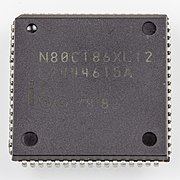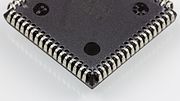Plastic Leaded Chip Carrier
Plastic Leaded Chip Carrier ( PLCC ) (according to JEDEC ), or Quad Flat J-Lead Chip Carrier ( QFJ ) is a 1976 introduced and 1984 standardized IC - housing shape with so-called J-lead terminals (J-shaped inwardly bent SMD all connections ). Often this design was chosen for flash memory , which z. B. contained the BIOS in the PC .
variants
Usually QFJs are square and have the same number of connections on all four sides, but some types have a rectangular base with two longer sides that have more connections than the two shorter sides, since the pitch - the distance between the connections - always 1.27 mm ( 1 ⁄ 20 inch = 50 mil ). The number of connections can be seen from the number after the type designation: QFJ52 (PLCC52). The following housing variants are common:
- QFJ20 (PLCC20) - (4 × 5 pins)
- QFJ28 (PLCC28) - (4 × 7 pins)
- QFJ32 (PLCC32) - (2 × 7 and 2 × 9 pins)
- QFJ44 (PLCC44) - (4 × 11 pins)
- QFJ52 (PLCC52) - (4 × 13 pins)
- QFJ68 (PLCC68) - (4 × 17 pins)
- QFJ84 (PLCC84) - (4 × 21 pins)
There are also the variants PLCC2 and PLCC4 (also referred to as PLCC-2 or PLCC-4), which are also square, but only have connections on two sides. These variants are mainly used for surface-mounted devices - light emitting diodes .

The pin counting is different from more modern QFP packages. It does not start at a corner, but in the middle of one side with pin 1. It is then also counted in an anti-clockwise direction.
Areas of application

As with any form of IC package, there are many different ICs available in such packages. Because there have been reliable sockets for this design for a long time, it often houses circuits with non-volatile memory. Such are among others:
- Microcontroller
- Flash memory e.g. E.g .: BIOS
- Interface building blocks
- LC display driver
- AD converter / DA converter
- EPLD
- CPLDs
- PICC
- Before the introduction of the PGA design, also for microprocessors and chipsets in personal computers
Due to its tall design, it is not used in highly integrated devices.
In the meantime, the components, provided they are still available in this design, are also RoHS- compliant.
advantages

- Sockets available.
- Component orientation easily recognizable due to the tall design.
- Hardly any short circuit formation during reflow soldering .
disadvantage
- Excessive component height
- Soldering point is hidden under the connection, therefore difficult to inspect.
- Due to stencil specifications, QFJs cannot, or only very poorly, be processed together with components in more modern chip packages such as TQFP , TSSOP or smaller in the same process (stencil printing / reflow soldering).
- Wave soldering is only possible with restrictions.
- This housing shape is no longer used that often and is correspondingly more difficult to obtain.
- One-sided contact via spring contacts is a constant uncertainty factor , especially in mobile applications
Packaging and processing
Available in bars or straps. Is equipped with pick-and-place or (mostly by hand) pressed into a previously soldered socket.
Web links
- PLCC standard. JEDEC, accessed November 11, 2012 (authorization required).
Individual evidence
- ^ Ray Prasad: Surface mount technology: principles and practice 1997, ISBN 0-412-12921-3 , p. 121.
- ↑ Package Outlines. Maxim Integrated, accessed December 21, 2017 .
- ↑ SOT187-2. NXP, February 8, 2016, accessed December 21, 2017 .
- ↑ Standard SMD LED. In: Farnell. Vishay, August 3, 2015, accessed December 21, 2017 .
- ↑ 44L_Square_L_C04-048B.fm. Microchip, 2017, accessed December 21, 2017 .
- ↑ 8-Bit CMOS Flash Microcntrlr with 32k Mem. Texas Instruments, 2013, accessed on December 21, 2017 (English).
- ↑ 25162A.pdf. Microchip, April 2013, accessed December 21, 2017 .
- ↑ PC16552D Dual Universal Asynchronous Receiver / Transmitter. National Semiconductor / Texas Instruments, June 2015, accessed December 21, 2017 .
- ↑ MM145453 Liquid Crystal Display Driver datasheet (Rev. C). Texas Instruments, March 2013, accessed December 21, 2017 .
- ↑ AD7528 Data Sheet. Analog Devices, February 23, 2017, accessed December 21, 2017 .
- ↑ ATF1504AS. Atmel, accessed December 21, 2017 .
- ↑ Microcontroller (MCU). Farnell, accessed December 21, 2017 .


